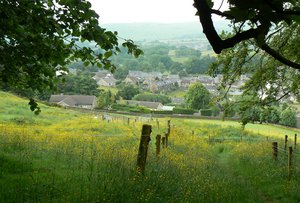Advertisement
Published: February 27th 2010

 Eyam
Eyam
From the hillcovered with wildflowersnot far from Mompesson's WellEverywhere we looked there were wildflowers in the glory of full bloom. Not just here and there, but swathes of them, through all the pastures and thick along roadsides and paths. For Claire, who has dreamed of having a meadow instead of a lawn in her garden, this was heaven. Even having to swallow twice-daily doses of anti-histamines to combat unending hay fever couldn't dampen her joy at wandering through the grasses and flowers. It was almost as good as coming to life in the poppy field scene in
A room with a view. And it was much, much better than our usual midsummer: trying to not move through Brisbane’s sweltering humidity.
We were in the Peak District to visit Dave's family, and we’d congregated at a cottage in Eyam for a week of catching up. And a hectic week it was, visiting local attractions, revisiting haunts from Levick family holidays decades ago, and otherwise hanging around Eyam, sharing long, winey dinners around the kitchen table and equally long evenings of "Remember when" around the smoky fire in the lounge.
Eyam is not far from the tacky tourist destination of Matlock Bath, and Claire learned that the specialty of

 Welcome to Eyam
Welcome to Eyam
Barbara and Dave in a typical street in the middle of the villagethe fish-and-chip shop that we saw on our visit in 2006—the Spam fritter—was still on offer. Once again, she refused to try this English delicacy. The family trawled around favourite holiday places of Dave’s childhood: the Devil’s Arse (was it called that when Dave was a boy or by it’s other name of Peak Cavern?), Winnat’s Pass, Thor’s Cave, which, once upon a time, began life as a coral reef in the tropics. Wherever we went there were seed heads and flowers.
And
well dressings of the region. This is a custom unique to the Peak District, and is believed to be rooted in pagan thanksgiving for clean water supplies, although, like many other pagan festivals and customs, was incorporated into Christian practices. The locals of at least 60 Peak District towns and villages dress the wells, disused now, with a design made of the petals, leaves and seeds of flowers, herbs and grasses. They only last a week or so, but the dedication put into them attests to people’s pride in their heritage—and not a bruised petal to be seen.
On one day we meandered along the Dove River between Dovedale (home of artery-challenging and delicious ice-cream from

 A Saxon souvenir from 800AD
A Saxon souvenir from 800AD
Cross among the headstones in Eyam churchyarda stall near the start of the walk) and Milldale. Izaak Walton, the author of
The Compleat Angler, lived near here and fished for trout in the river in the mid-17th century. It’s still a popular pastime, if the anglers we passed are any guide. And the Romantic poet
Lord Byron praised the area, too, which he claimed had ‘prospects… rivalling those of Switzerland and Greece’.
Another day, the whole family wandered for a time along the
Tissington Trail, starting from a place called Parsley Hay, which seems to be the sort of winsome name place that Beatrix Potter might invent. This trail is part of the 19,000km of trails that make up the
National Cycle Network, some of them, like Tissington, refurbished from disused railway beds. This inspired transformation is one of the civilised, community-building exercises that Great Britain does so well and that Australia could learn much from. Near the intersections with roads, such as at Parsley Hay, it must be very difficult for the many cyclists who use the trails, because they are clogged with pedestrians paying not a whit’s attention to other users, but everyone seems to remain good natured about it. We itch to be on our bikes and peddling
off down the trail.
While we were at Parsley Hay, we strolled across the road to visit
Arbor Low, despite Stan’s protests. “Not a
pile of old stones,” he said. However, the visitor from Australia held the trump card and off we all went. It turned out to be entertaining, partly because the dairy cows hung around, chewing their cuds impassively among these stones that were laid here with precision between 4,500 and 6,000 years ago, in what is now the middle of a farmer’s paddock.( “They’re fields here,” Dave corrected me, repaying me for doing the same to him at home.) Mostly, though, it was because it happened to be the summer solstice and all sorts were out, marking the date in their self-designed and culturally jumbled ways. People in one small group were meditating in the lotus pose and chanting “Om”. It
is a remarkable site, and remarkable that it has survived so many millennia.
A highlight of the week for Claire was a visit to
Haddon Hall, one of the ‘lesser’ great houses. This one was humble relative to, say, the nearby Chatsworth House. The lines were clean, beautiful. The wood panelling in the rooms was exquisite, and complemented the
stonework, giving the place a sense of spaciousness and restraint. It was a joy to be in spaces so soulful. And Wendy murmured over the flush of delphiniums in the garden, appreciating how difficult they are to grow. Even the entrance impressed Claire: the owners leave the meadow leading to the main entrance unmowed, a conservation project to encourage the spread of wild grasses and herbs endemic to the area. The house is advertised as one of England’s oldest; apparently there has been a building on the site since Norman times, and it’s mentioned in the
Domesday Book.
Eyam, too, is listed in the Domesday Book. Lead was mined here for centuries from Roman times until the 1960s. The locals also made a living from quarrying for limestone, sandstone and millstone grit, and millstones were manufactured in the region from medieval times until the 1930s. A small quarry remains today, continuing an ancient tradition. It brought this disappeared way of life closer to realise that it still thrived in the lifetime of Dave’s mum, Barbara, who is with us and sharing many stories of her long and active life. In the 18th century, Eyam was a centre of cotton spinning,
which was replaced by silk weaving the following century.
A Saxon cross, now in the churchyard, is a souvenir of worship from around 800 AD, well before the Norman Conquest. In the
Eyam church the locals display the register of baptisms, marriages and deaths, left open on a page listing deaths from the plague that struck in September 1665, and took the lives of 260 of the 800 villagers by the time it ended in October 1666. It’s stirring, seeing this hand-written heartbreak of a community marking itself wasting away. The Eyam folk of the time did a remarkable thing when the plague struck: they quarantined themselves from the outside world, to stop its spread. They established exchange points at several places outside the village, where food, other goods, and news could be traded.
Eyam is also notable for having one of the first public water systems in Great Britain. Stone troughs were built for domestic and agricultural use throughout the village, starting in 1558, and they continued to supply water for domestic use for nearly 350 years. Some still exist.
Dave and I spent one day hiking up the Eyam Edge and across the moor into

 'There's the remains of a stone circle here somewhere!'
'There's the remains of a stone circle here somewhere!'
On Eyam Moor. The white-flowering cottongrass helps bind the peat on which it grows.the next valley, returning via the Barrel Inn, which happened to be on our route and has been quenching thirsts since the 1590s. The United Kingdom has a fantastic system of hiking trails. Or rambling, as the locals call it. Most of where we walked was on public rights of way through private land, much of it farmed. Some of the pathways are ancient: Romans trod these same paths. There are so many paths criss-crossing each other, it helped to have the beautifully made Ordnance Survey maps so that we ended up back at Eyam at the end of the day. And all day—wildflowers!
At the end of the week, everyone exhilarated and exhausted by this rare opportunity to spend so much time together, we took a picnic—sorry, pack-up—to the Derwent Dam, further north. The dam walls have been built to look like castle walls with battlements. It was here, during World War Two, that the famous
Dambusters of the Royal Air Force’s No. 617 Squadron ran flights to finetune their technique for dropping bouncing bombs, which were designed to destroy the walls of Ruhr dams during air raids on Germany. It was such a peaceful day when we

 Somewhere to rest your weary bones
Somewhere to rest your weary bones
A seat for ramblers in the middle of a fenced off field of ferns. Strange. Unexpected. But nice views.were there, under the quaint dam walls.
From here, we headed for Bury, near Manchester, to stay with Dave’s sister Sheila and brother-in-law Stan for a weekend.
They shared with us one of their favourite places, Ynys Llanddwyn, at Anglesey in north Wales. The moment we arrived, we could see the attraction of this place for these two beach-lovers. The light had such a presence, you could feel yourself walking through blue that spilled from the sky and the sea. It was hot and fine enough to swim, a lovely last day of the English part of our holiday.
Having spent so much money on flying half way around the world, we couldn’t just stay for a week. So we’d brought our bikes with us, and tomorrow we are off on a cycling trip, both of us to western and northern Scotland, and then Claire to the Lofoten Islands. We’ve put our bikes together, packed our gear, and said our goodbyes to Barbara, whose voice carries the weight of sadness of missing her son already. We feel vividly how far we live from Dave’s family. Tomorrow we’ll ride 11 km down the road to the catch the
train to Oban, in Scotland. Where, quite probably, we'll ride through wildflowers.
Advertisement
Tot: 0.085s; Tpl: 0.012s; cc: 14; qc: 29; dbt: 0.0271s; 1; m:domysql w:travelblog (10.17.0.13); sld: 1;
; mem: 1.2mb























